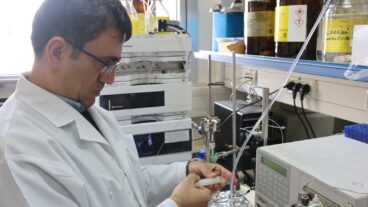Israeli scientists believe that Huntington’s and similar diseases may be caused by the accumulation of DNA repeats.Of all the diagnoses to receive from a physician, Huntington’s disease must rate up there as one of the worst. For sufferers of the rare inherited disorder, which strikes in mid-adulthood and manifests itself as an excruciatingly predictable process of neurological decline, death arrives just when the doctors say it will. There is no cure.
Researchers at Israel’s Weizmann Institute of Science in Rehovot have recently shown, however, that it is possible to explain the mechanisms by which this genetic time bomb maintains its remarkable precision. And if it’s possible, they say, to explain such punctuality in molecular terms, then it’s likely too that one day soon the operation of Huntington’s may also be clarified – and, with a little luck, vanquished altogether.
It’s all to do with gene segments called “trinucleotides” – little three-letter lengths of DNA which appear repeatedly in the gene which codes for Huntington’s. If a certain trinucleotide appears less that 40 times in that particular chronomosomal chunk, then symptoms will not ensue. But if the sequence continues for more than 40 repeats to over 70, then the characteristic Huntington’s abnormalities arise – a progressive decline in muscle control and some cognitive abilities – and proceed to rob the sufferer of independence, hope, and a future.
For many years, scientists have been aware that it is possible to map the age that Huntington’s will appear and how quickly the disease will progress in a patient according to the number of times the sequence repeats in their DNA.
Traditionally, it was thought that this predictability was due to the build-up of a protein fragment containing the amino acid (glutamine) in the repeating triplet that eventually reached toxic levels. If the trinucleotide coded for glutamine, then it seemed to follow that the greater number of trinucleotide repeats, the more drastic the effect of the accumulated glutamine.
This theory does not, however, explain all of the clinical data. Why, for example, do patients with two copies of the Huntington’s gene not exhibit symptoms earlier than those with a single copy? In addition, glutamine is not produced in every trinucleotide disease, but the correlation between sequence repeats and onset age follows the same order in each of them.
The Weizmann scientists looked at the evidence and realized that the actual mechanism at work could be completely different. In a paper published in the journal PLoS Computational Biology, biological chemistry and computer science research student Shai Kaplan suggests that the process behind Huntington’s might have more to do with somatic mutations – changes in the number of DNA repeats that build up in our cells as they naturally renew themselves throughout our lives.
Using existing literature on some 20 similar trinucleotide repeat diseases, Kaplan, together with Professor Ehud Shapiro and Dr Shalev Itzkovitz, created a computer program able to simulate the process of cell division with reference to the number of DNA repeats, age of disease onset and rate of progress. Noticing a correlation between repeat sequence length and intensification of symptoms, the scientists postulated that Huntington’s and similar diseases may be caused by the accumulation of DNA repeats – not of proteins such as glutamine.
The new model appears to fit all of the facts, but Kaplan, Shapiro and Itzkovitz now plan to test their theory further. The scientists will test the Huntington’s theory in the laboratory, hoping to pursue their research towards some treatment method which slows down the rate of cell division – and transforms a terrifying diagnosis into something far more benign.![]()
Slashdot It!![]()












